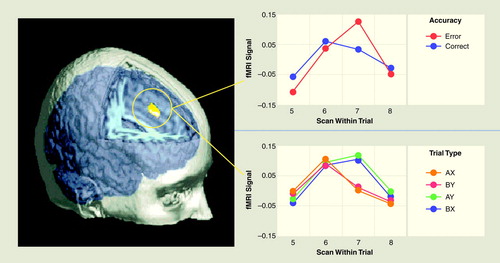Cognition: Executive Function
The development and widespread use of functional brain imaging over the past decade has generated a dramatic increase in interest in identifying the neural mechanisms underlying human cognition and behavior. “Executive function” comprises a broad class of mental processes involved in initiating and maintaining smooth information processing and coordinated actions in the central nervous system. They include strategic processes, such as attention allocation and goal representation and maintenance, and evaluative processes, such as on-line performance monitoring; this latter can indicate the degree to which strategic processes need to be engaged to maintain stable performance. One region of the human brain consistently associated with executive function is the anterior cingulate cortex, located on the medial aspect of the frontal cortex adjacent to the corpus callosum. The anterior cingulate cortex has rich bidirectional connections with the frontal, parietal, temporal, and entorhinal association cortexes and the amygdala. Several mechanisms have been proposed to conceptualize how the anterior cingulate cortex exerts its executive function—through motivated attention, attention for action, or error detection. Event-related functional magnetic resonance imaging (fMRI) suggests that although the anterior cingulate cortex does indeed show error-related activity, it detects conflicts such as response competition, which in turn may result in errors, rather than detecting errors per se.
In this sense, the anterior cingulate cortex can be considered part of an “error-prevention” brain system. This evaluative function of the anterior cingulate cortex can be considered motivational insofar as the anterior cingulate cortex is signaling that strategic processes need to be controlled. There is also evidence that although the anterior cingulate cortex signals the need for strategic processes, it does not implement those processes. Other regions of the distributed neural network underlying executive function, including the dorsolateral prefrontal cortex and parietal cortex, appear to serve those functions. The figure shows data from an event-related fMRI experiment in which activity in the anterior cingulate cortex was observed during incorrect and correct trials. The data confirm the results of electrophysiological studies suggesting that the anterior cingulate cortex shows error-related activity. However, the same region also shows activity during correct trials in which conflict occurs. These data are consistent with an emerging model for how the brain regulates its own function on a moment-to-moment basis to adapt to the constantly changing demands of our environment by using conflict as an alerting signal; the data suggest a key role for the anterior cingulate cortex in this process. It is likely that disturbances in the evaluative functions of the anterior cingulate cortex are related to the breakdown of the normally seamless adaptation that occurs in illnesses such as schizophrenia and obsessive-compulsive disorder. This is likely to ensure that examination of the role of the anterior cingulate cortex will remain an active area of research in cognitive neuroscience for many years to come.
Image is courtesy of Dr. Carter.

FIGUREError-related and conflict-related activity in the anterior cingulate cortex during the modified AX Continuous Performance Test. Transient, response-related activity was greater during incorrect than correct responses, confirming that the anterior cingulate cortex shows error-related activity. During correct responses, however, the same region also showed transient, response-related activity, which was greatest during trials that elicited response conflict (AY and BX trial types).



